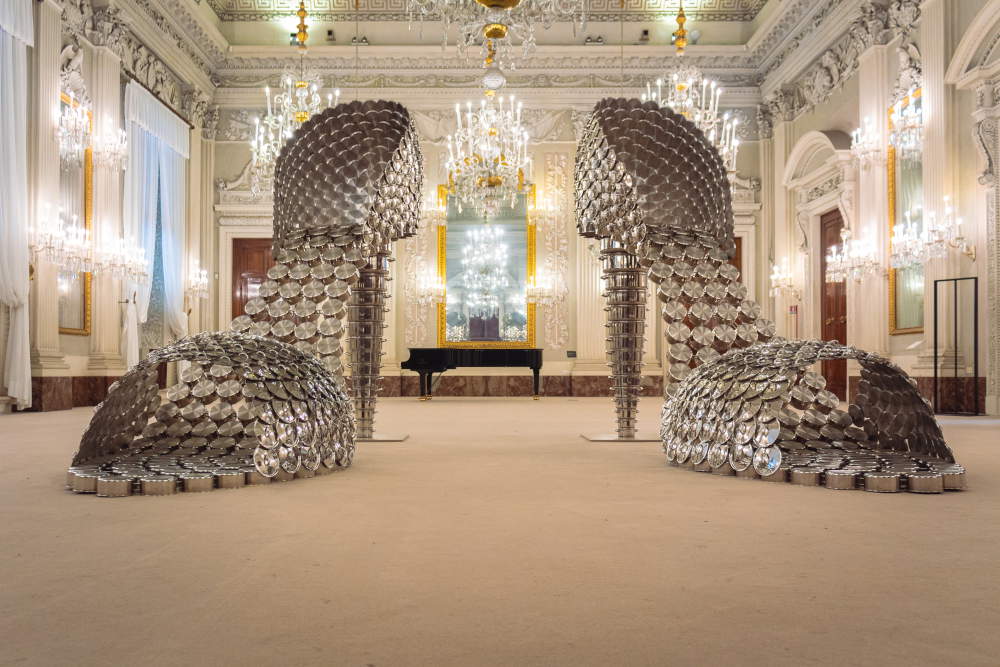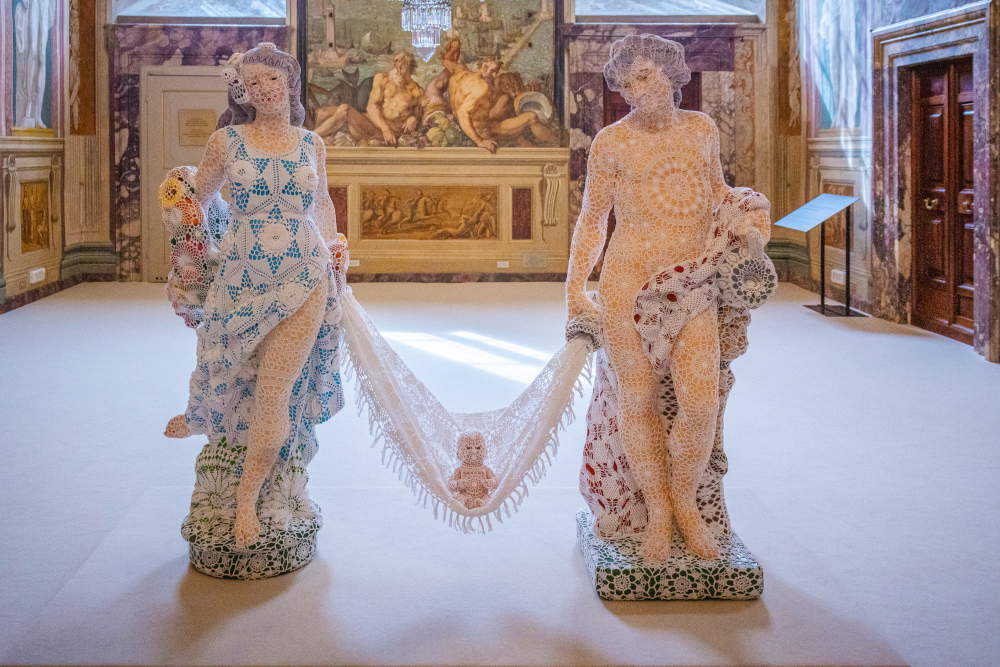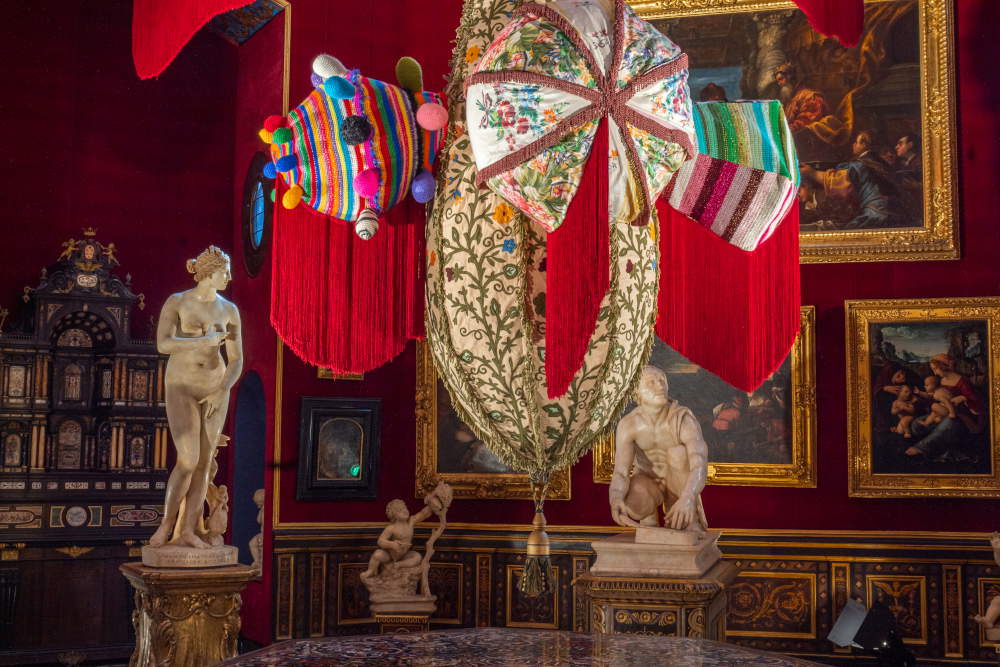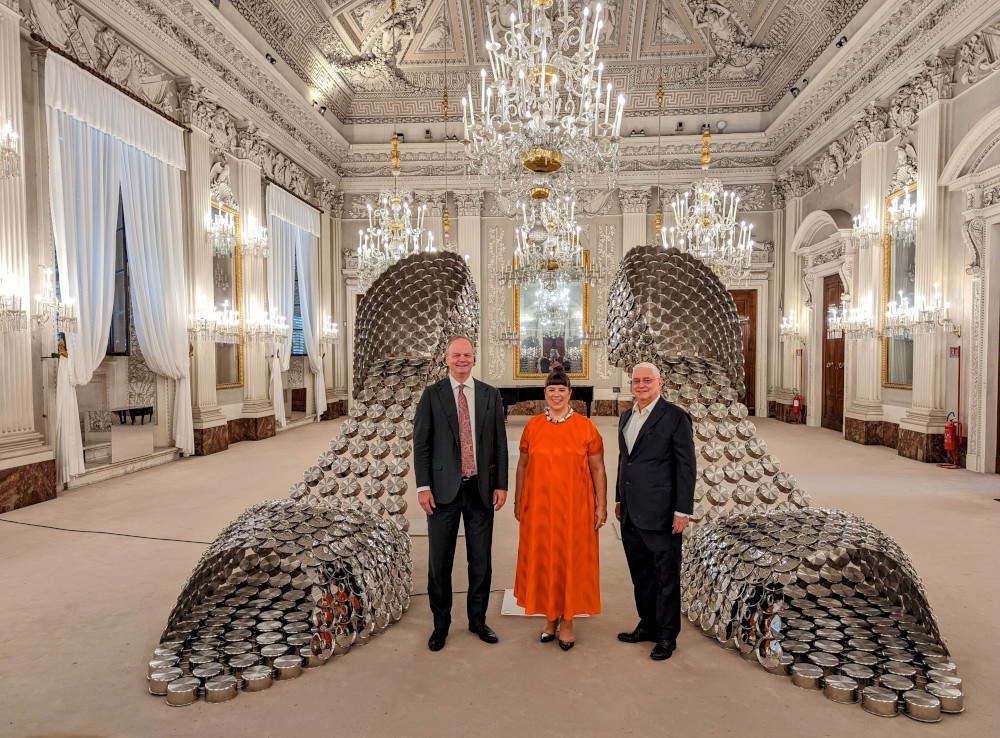Three large installations by Joana Vasconcelos arrive at the Uffizi and Palazzo Pitti
From Oct. 4, 2023, to Jan. 14, 2024, the Uffizi Galleries will welcome three major installations by Joana Vasconcelos, a visionary Portuguese artist who combines myth, history and tradition with irony and irreverence to challenge conventions and gender stereotypes. Between Sky and Heart, this is the title of the exhibition curated by the director of the Uffizi Galleries Eike Schmidt and Demetrio Paparoni, thus brings to the Florentine museum venue three of her most important works that reinterpret tradition and have their roots in both popular culture and the Portuguese Baroque.
The White Room of the Pitti Palace will host Marilyn, a giant pair of high-heeled sandals meant to recall those worn by Marilyn Monroe in the film When the Wife is on Vacation. But one notices something strange: the footwear is in fact composed not of elegant metal links, but of mirrored steel pots accompanied by their lids. Common kitchen utensils thus compose a fashion object in a monumental key. In the contrast between the sensuality of the feminine and the domestic role to which women have traditionally been relegated, Joana Vasconcelos transforms the tools of everyday life, decontextualizing them through assemblage, into a powerful weapon to challenge gender paradigms. Making the meaning explicit from the work is irony, a mode of communication that has always enabled the Portuguese artist to deal lightly with thorny and controversial issues.
On the other hand, Happy family, a disorienting reinterpretation of the Christian theme of the Holy Family, will be exhibited in the Sala di Bona of Palazzo Pitti. The delicacy of ceramics and the lightness of wood, usually favored for this type of sculpture, are replaced by the hardness of concrete, whose overbearingness and masculinity are, however, enveloped by the femininity and sweetness of a crocheted artifact. While the lace, by covering their nudity, seems to want to contain the sensuality of the figures, the transparencies of the embroidery want to multiply their erotic charge. Happy family is then charged with a pronounced life force that is propagated in the choice of characters: instead of Mary and Joseph, Vasconcelos chooses two subjects from the pagan tradition, a Flora and a Bacchus, who by cradling the doll-child on a soft naperon, make him a participant in a pagan rituality. Through this metamorphosis of the subject, the divine is transposed into a ritual of Dionysian effusion; the original subject’s message of salvation is converted into a hymn to life and rebirth, into an exaltation of eroticism and the joy of existence.
Royal Valkyrie, one of the monumental hanging sculptures that make up the Valkyrie cycle, finally stands out on the ceiling of the Uffizi Tribune: an intricate weave of fabric, wool, cotton, cords, padding, sequins, beads, feathers and LEDs. The Valkyries have traversed the centuries as implacable, unyielding warriors, endowed with a superhuman strength capable of subduing any form of life; by adorning them with fabric, Joana Vasconcelos restores to them the sensuality and delicacy of which they had been deprived, while at the same time enhancing their role as champions of freedom. If the grandeur of the sculpture drips with the warrior spirit of myth, the enveloping sinuosity of the material clothes the Valkyrie with the empathy of one who knows how to feel compassion and fights for a different perception of female power.
If on the level of technique the artist makes use of craft practices and appropriates objects related to domestic life, on the level of design she adopts an architectural scale that requires an engineering study and is able to amaze the observer at first glance.
“Marilyn Monroe’s heels in monumental proportions, the typical family nucleus (father-mother-son) transposed in irritating terms, the warrior woman but wrapped in colorful weaves and crocheted gale: Joana Vasconcelos’ installations present us with an obviously feminist crescendo, yet without recriminations or grudges about historical gender roles. On the contrary, it is precisely the cheerful irony of her creations that disorients us and makes us reflect on roles and the effective, disruptive power of women,” said Director Eike Schmidt.
“Whenever one attends a Vasconcelos exhibition, one has the feeling of seeing unseen works even when the works being exhibited are iconic, already known to the general public,” added curator Demetrio Paparoni. “The installation of Vasconcelos’ monumental Valkyrie in the Tribuna Hall of the Uffizi is in itself an extraordinary and unrepeatable event. Made of fabrics, embroidery and padding, soft and flexible materials, the work adapts and blends with the environment, which itself becomes a component of the installation. Also unrepeatable and extraordinary is the presence at the Pitti Palace of the other works, including the well-known Marilyn, made of pots and lids made of mirrored steel. Exhibited in the White Room, Marilyn absorbs and returns the energy of this large, luminous hall and its majestic stuccoes, mirrors and chandeliers.”
“I am a contemporary artist, participating in the creation of this historic moment, and I would never have dreamed of exhibiting in the museum where works by Leonardo Da Vinci, Michelangelo or Caravaggio are housed. This invitation from the director of the Uffizi is a great honor. Because regardless of whether we are talking about living or dead artists, what matters most is the dialogue that is generated between the works,” the artist said. “The building itself provides the framework for artistic production, regardless of the century from which it comes. This space has the magical power to erase time; it is like a time machine. The most wonderful thing about the Uffizi is the history of art.”



 |
| Three large installations by Joana Vasconcelos arrive at the Uffizi and Palazzo Pitti |
Warning: the translation into English of the original Italian article was created using automatic tools. We undertake to review all articles, but we do not guarantee the total absence of inaccuracies in the translation due to the program. You can find the original by clicking on the ITA button. If you find any mistake,please contact us.



























